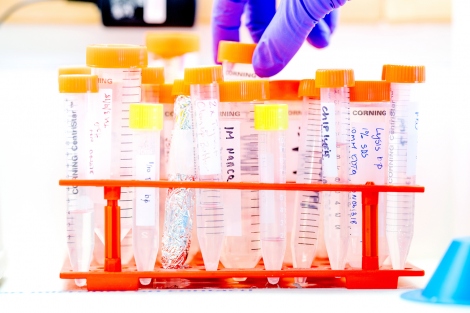
Alex Marson, MD, PhD, UCSF immunologist whose group has developed an approach to edit T-cells directly with CRISPR gene-editing, speaks with MD/PhD student Theo Roth. Credit: Noah Berger.
In an achievement that has significant implications for research, medicine, and industry, UC San Francisco scientists have genetically reprogrammed the human immune cells known as T cells without using viruses to insert DNA. The researchers said they expect their technique—a rapid, versatile, and economical approach employing CRISPR gene-editing technology—to be widely adopted in the burgeoning field of cell therapy, accelerating the development of new and safer treatments for cancer, autoimmunity, and other diseases, including rare inherited disorders.
The new method, described in the July 11, 2018 issue of Nature, offers a robust molecular “cut and paste” system to rewrite genome sequences in human T cells. It relies on electroporation, a process in which an electrical field is applied to cells to make their membranes temporarily more permeable. After experimenting with thousands of variables over the course of a year, the UCSF researchers found that when certain quantities of T cells, DNA, and the CRISPR “scissors” are mixed together and then exposed to an appropriate electrical field, the T cells will take in these elements and integrate specified genetic sequences precisely at the site of a CRISPR-programmed cut in the genome.
“This is a rapid, flexible method that can be used to alter, enhance, and reprogram T cells so we can give them the specificity we want to destroy cancer, recognize infections, or tamp down the excessive immune response seen in autoimmune disease,” said UCSF’s Alex Marson, MD, PhD, associate professor of microbiology and immunology, a member of the UCSF Helen Diller Family Comprehensive Cancer Center, and senior author of the new study. “Now we’re off the races on all these fronts.”

But just as important as the new technique’s speed and ease of use, said Marson, also scientific director of biomedicine at the Innovative Genomics Institute, is that the approach makes it possible to insert substantial stretches of DNA into T cells, which can endow the cells with powerful new properties. Members of Marson’s lab have had some success using electroporation and CRISPR to insert bits of genetic material into T cells, but until now, numerous attempts by many researchers to place long sequences of DNA into T cells had caused the cells to die, leading most to believe that large DNA sequences are excessively toxic to T cells.
To demonstrate the new method’s versatility and power, the researchers used it to repair a disease-causing genetic mutation in T cells from children with a rare genetic form of autoimmunity, and also created customized T cells to seek and kill human melanoma cells.
Viruses cause infections by injecting their own genetic material through cell membranes, and since the 1970s scientists have exploited this capability, stripping viruses of infectious features and using the resulting “viral vectors” to transport DNA into cells for research, gene therapy, and in a well-publicized recent example, to create the CAR-T cells used in cancer immunotherapy.